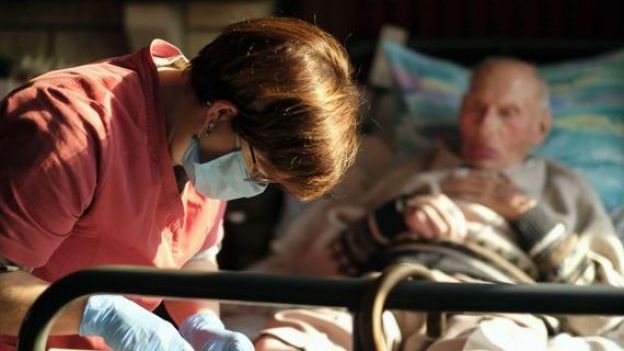The fatality rate in retirement homes is high in most countries, ranging from about one-third to half of all reported deaths. Until now no certain figures were available on the situation in Belgium because of lack of tests and experts were inclined to dismiss the alarming figures on suspected cases as overestimates.
This is hardly possible any longer since the Belgian health authority, Sciensano, today (16 April) published detailed statistics on the situation in the retirement homes. The figures do confirm an earlier report by the European Centre for Disease Prevention and Control (ECDC) that showed an all-cause excess mortality above the expected rate in Belgium and other countries among elderly people.
Until now, the Belgian authorities have claimed that it would take some time to analyse the figures and assess whether more people at the retirement homes have passed away during the crisis than before.
Epidemiologist Brecht Devleesschauwer from Sciensano tweeted on Thursday that excess mortality is significantly increasing since mid-March and exceeds the levels during the 2018 influenza season.
2- Since mid March, excess mortality is significantly increasing, from +12% (15-21/03) to +77% (29/03-04/04). Excess mortality levels are exceeding those of the 2018 influenza season. pic.twitter.com/CeXsFoexzF
— Brecht Devleesschauwer (@brechtdv) April 16, 2020
Sciensano’s daily report specifies that 69 % of the reported 417 deaths during the last 24 hours took place in retirement homes. This brings the total number of deaths to 4,857. Almost half, or 49 %, are reported from the retirement homes.
Before, almost all cases in the retirement homes were suspected cases. Since a program of extensive testing started on 10 April, the number of confirmed cases is increasing.
Out of the planned 20,000 tests of residents and staff at the retirement homes, about 13,500 have been carried out until now. As previously reported, the results show that 20 % of the residents and 13 % among staff were tested positively for COVID-19. Overall, more than 6,000 tests are carried out daily in Belgium. The number of laboratories has increased to 72, including private laboratories.
If there have been any doubts before whether elderly people from retirement homes, with or without underlying conditions, received hospitalisation, the daily report shows that about half of all hospitalised people are older than 70. The report also states that the percentage of elderly people at the hospitals has increased.
Protecting the elderly
At today’s on-line press conference by the World Health Organisation (WHO), The Brussels Times asked the organisation about its assessment of the situation in the retirement homes and if there is a strategy that countries should adopt to protect the elderly and reduce the high mortality rate in the retirement homes.
Catherine Smallwood replied that the situation in the retirement homes is tragic and difficult. “Older people living in care homes are vulnerable for two reasons.”
“First because of who they are - residents are older and many have underlying conditions. But also because of where they live - retirement homes might be crowded with frequent contact between residents, carers and visitors who are coming and going.”
She said that residents at retirement homes that have been confirmed as infected with COVID-19 should be hospitalised. Measures need to be taken to protect residents, staff and visitors. Everything must be done to prevent the virus from entering the homes. A comprehensive approach is necessary, including testing and supply of protective equipment.
On the positive side, at the hospital, the majority of infected people, according to Sciensano’s figures, do not need intensive care and receive other treatment. Ventilation with respirators is an invasive and dangerous treatment, also for staff, where the outcome is difficult to foresee.
According to American journalist Nicholas Kristof, who was allowed to visit the emergency wards at two hospitals in New York, there is no large-scale data but in New York as many as four out of five COVID-19 patients who are intubated might not survive (The New York Times, 14 April).
“Normally, intensive care is only given to severely ill patients whose state of health might otherwise deteriorate,” dr Thomas Lindén, a Swedish Government Chief Medical Officer, told The Brussels Times in a previous interview. Most hospitalised people have minor symptoms.
Asked about the survival chances with ventilation, he replied that the results differ by country depending on age structure, underlying health conditions, and statistical reasons. “Often the survival rate is about 50 %.” Dr Björn Persson, Director at Karolinska University Hospital, Stockholm, said that a person with a biological age above 80 with respiratory failure because of COVID-19 has slim chances of survival.
M. Apelblat
The Brussels Times

